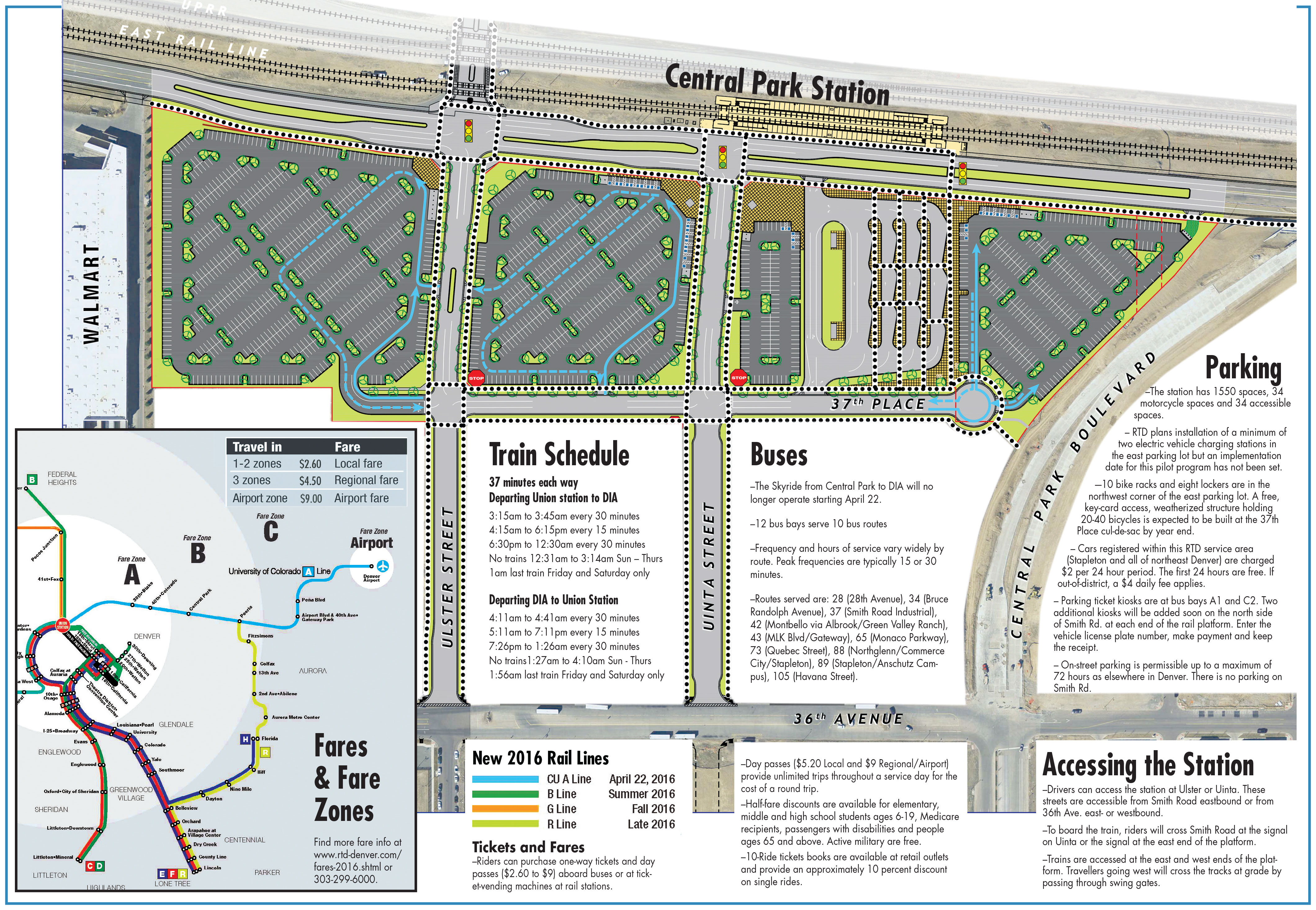Click here to view a larger image of the graphic above.
The long-awaited commuter rail service from Union Station to DIA opens to the public mid-day on Friday, April 22. A ceremonial trip for elected officials and other dignitaries begins around 7:30am at Denver Union Station and concludes with speeches and an official grand opening event at the DIA station from 10am to 12 noon. The trains will run at 15-minute intervals and will be free through Saturday the 23rd—and all of RTD’s rail lines will be free that Saturday.
Also on Saturday, a Central Park Station “Street Party” will be held from 10am to 2pm to celebrate the arrival of commuter rail service to Stapleton.
The trip will take 37 minutes end-to-end. Central Park to downtown will take 14 minutes while the airport trip from Stapleton will last 23 minutes. Trains will run approximately 22 hours per day at 15-minute intervals (30 minutes late at night or early in the morning). Fares will range from a local, two-zone, one-way cost of $2.60 to $9 for any trip to the airport. (See schedule and fare information at left.)
The new service is officially called the “University of Colorado A Line” because CU purchased naming rights for five years at a cost of $5 million.
Voter Authorization of FasTracks
In November 2004, regional voters overwhelmingly approved “FasTracks,” and now 12 years later the promise of that ballot proposal is delivering a new transportation choice. The voter approval authorized the Regional Transportation District (RTD) to begin developing the nation’s most ambitious mass transit system build-out: 122 miles of new commuter and light rail along with 18 miles of bus rapid transit and enhanced bus service across an eight-county district. Now with $5.2 billion expended or committed for FasTracks, commuter rail service is coming to the Central Park Station.
What Is Commuter Rail?
Commuter rail is new to Colorado. Light rail has served portions of Denver since the mid ’90s. Commuter rail features heavier vehicles capable of higher speeds (up to 79 miles per hour). To take advantage of that capability, stations are spaced farther apart, hence the “commuter” label. RTD selected electric power for the commuter rail lines just as they did for light rail.
The A Line will operate partly within its own, exclusive corridor such as north of I-70, but also within the pre-existing Union Pacific main line corridor, as within Stapleton. Federal safety rules would not have allowed lighter weight “light rail” vehicles to share a corridor with freight traffic—another reason RTD selected commuter rail technology for this corridor.
Along its 23-mile corridor, the A Line will connect Denver Union Station and DIA with six intervening stations: 38th and Blake, 40th and Colorado Blvd., Central Park, Peoria, Airport Boulevard and 40th, and 61st and Pena.
Connecting Rail Lines
On day one, the A Line will connect with three light rail lines at their downtown terminus: the southwest or “C” line to Highlands Ranch, the southeast or “F” line to Lone Tree and the west or “W” line to Lakewood and Golden. By the end of the year it will connect at the Peoria station with the “R” light rail line that is being constructed within and parallel to I-225 in Aurora. Also by the end of 2016, it will connect with two new commuter rail lines: the “B,” which is segment one of the northwest line ending in Westminster (W. 69th Ave. and Grove St.), and with the “G” line being built to Ward Road through Arvada and ending in Wheat Ridge. (See RTD zone map below)
P3—A Public-Private Partnership
The A, B and G lines constitute a project dubbed EAGLE P3 in which RTD entered into a 34-year agreement with a concessionaire, Denver Transit Partners (DTP), to finance, build, operate and maintain the system. RTD makes so-called “availability” payments to DTP if it meets performance standards. DTP repays its private financing from that amount, much as home mortgages are repaid. “P3” refers to the fact that this is a true public-private partnership. The $2.2 billion project includes a $1.03 billion federal grant that RTD was awarded.
Street Crossings
Although new rail and roadway bridges were constructed in key locations, such as where the line passes under Peoria Street, 13 “at-grade” crossings remain, such as at Ulster and Havana streets. At such surface crossings, RTD has constructed a variety of safety measures including gates, fencing, medians, flashing lights and bells. These measures enabled Denver and Aurora to apply to the federal government for “quiet zone” status, which, if approved, will permit not only A Line trains but also the freight trains to run silently through the crossings; i.e., the operator will not blow the horn. The end result will be far fewer “high lonesome” train horn soundings despite the great increase in local train traffic.
As of this writing, the quiet zone had not yet been “established” by the Federal Railroad Administration (FRA). RTD says quiet zones have been applied for and approval is forthcoming. The start date of the quiet zones will depend on when approval is given. RTD, Denver and Aurora are working to have the date be on or near opening day—they will announce when they have the approval.
Positive Train Control
Another key feature of the A Line is new technology referred to as “positive train control” (PTC), a complex system designed to absolutely prevent incidents that might be caused by operator error (see March issue of the Front Porch). The A Line PTC is the first such system to be developed for a fully brand-new rail service. As of this writing, the PTC system is still being tested and is undergoing approval by the FRA. RTD says PTC will be functioning on opening day.





0 Comments